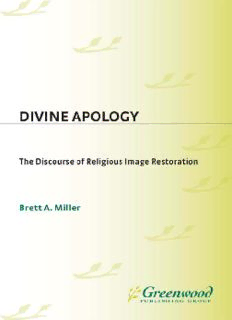
Divine Apology: The Discourse of Religious Image Restoration PDF
Preview Divine Apology: The Discourse of Religious Image Restoration
Divine Apology This page intentionally left blank Divine Apology The Discourse of Religious Image Restoration BRETT A. MILLER FOREWORD BY WILLIAM L. BENOIT PRAEGER W Westport, Connecticut London Library of Congress Cataloging-in-Publication Data Miller, Brett A., 1964- Divine apology : the discourse of religious image restoration / Brett A. Miller ; foreword by William L. Benoit. p. cm. Includes bibliographical references and index. ISBN 0-275-97548-7 (alk. paper) 1. Rhetoric—Religious aspects—Christianity—History. 2. Verbal self-defense— Religious aspects—Christianity—History. I. Title. BR115.R55M55 2002 273—dc21 2001058042 British Library Cataloguing in Publication Data is available. Copyright © 2002 by Brett A. Miller All rights reserved. No portion of this book may be reproduced, by any process or technique, without the express written consent of the publisher. Library of Congress Catalog Card Number: 2001058042 ISBN: 0-275-97548-7 First published in 2002 Praeger Publishers, 88 Post Road West, Westport, CT 06881 An imprint of Greenwood Publishing Group, Inc. www.praeger.com Printed in the United States of America The paper used in this book complies with the Permanent Paper Standard issued by the National Information Standards Organization (Z39.48-1984). 10 9 8 7 6 5 4 3 21 Contents Foreword by William L. Benoit vii Acknowledgments ix Introduction: Saving Faith, Saving Face 1 Part I: The Historical Apologists 1 Paul's Apostolic Apology in the Epistle to the Galatians 19 2 Justin Martyr's Defense of the Persecuted Church 33 3 Here I Stand: Martin Luther's Defense before the Diet of Worms 51 Part II: The Contemporary Apologists 4 Sin, Sex, and Jimmy Swaggart's Sermonic Apology 69 5 Jesus Crisis: Controversy in the Search for the Historical Jesus 83 6 Standing by Their Men: Southern Baptists and Women Scorned 103 vi Contents Part III: Interpretations 7 Implications for Religious Rhetoric 125 8 Implications for Image Restoration Discourse 145 Bibliography 153 Index 167 Foreword I mage repair discourse, or apologia, has been a recognized fruitful area for rhetorical criticism for decades. Essays in the 1950s by Baskerville (1952) and Jackson (1956) may constitute the earliest such studies. Rosenfeld's Nixon/Truman analogy (1968) was followed by one of the most famous studies in this area by Ware and Linkugel (1973). The majority of work on apologia (as Divine Apology's re- view demonstrates) has focused on political and corporate image repair, with relatively few studies of religious apologia. Divine Apology is an important contribution to the literature and should re- dress the existing imbalance. Although a few book chapters and ar ticles cover this topic, this is the first extended work in this area. Apart from the importance and past neglect of the topic it takes up, Divine Apology is a solid, well-written rhetorical criticism. First, the texts selected represent a very useful balance between historic and contemporary apologia. Moreover, Divine Apology critically analyzes a wide range of apologies: individual rhetors and groups as well as rhetors defending against a variety of accusations. The scope of this study makes it an important contribution to our understanding of religious image repair. Vlll Foreword Second, Professor Miller has done a fine job of critically analyzing these artifacts. He begins (a la Ryan, 1982) with a careful consider ation of the context and accusations that prompted these image re pair efforts. When he turns to critical analysis, he actively engages the text, helping his analysis come alive for readers with appropriate excerpts and keen insights. When he takes up the task of evaluating these discourses, he judges their appropriateness and then seeks evi dence, where available, to confirm his assessments. In many ways the heart of the book comes in the final two chap ters, in which Divine Apology teases out implications for religious rhetoric and for image repair discourse. Insights are offered for rhe torical theory generally, for apologia specifically, and for religious discourse. Students and scholars in any of these areas would find this book very rewarding. Professor Miller has written a fine book, an important contribution to our understanding of religious apologia. William L. Benoit University of Missouri-Columbia Acknowledgments I t would be completely inappropriate if I did not begin by estab- lishing my indebtedness to William Benoit. His mentoring, guidance, and encouragement were invaluable to me as I pursued this project. Pamela Benoit also read early drafts of this manuscript and provided important theoretical and structural support. Critical commentary by Michael Kramer and Michael Porter helped make this a better book. Paul Johnson was extremely helpful in causing me to question my perspectives and to stretch beyond the comfortable. I thank Joseph Blaney for setting the bar high and supporting me with candor and good humor through the research and writing process. My editor, Suzanne Staszak-Silva, the production staff at Greenwood, and the anonymous reviewers for my manuscript provided some insightful guidance. I owe a great debt to Stephanie Schierholz for her assis tance in preparing the final manuscript. I also wish to thank numer ous teachers and colleagues, including Holt Spicer, Donal Stanton, John Sisco, James Sneegas, Gary McGee, Penni Pier, and Bob Derry- berry, who assisted and influenced me in one way or another. Finally I thank my friends and family, especially Betsy, Cassidy, and Carsen, for their patience and grace.
Description: